
50cc Roadracing 1962
The 1962 World Championship.For the world championship races from now on, I will confine myself to the main players, but if an interesting outsider pops up, we'll have a look at that one too. KreidlerThe Kreidler works racer for the 1962 season was closely based on the Coupe d'Europe machine, but improved in many respects. Kreidler1 shows the Kreidler as it appeared for the 1962 season. The engine had a bore and stroke of 40 x 39.7 mm with two rotating inlets with two Bing carburettors. The foot change four-speed gearbox had again a hand changed (with a rotating grip on the left-hand clip-on) 3 speed box behind it, which gave a total of twelve speeds. Not every rider was happy with this arrangement, but Hans-George Anscheidt and Dutch riders Cees van Dongen and Jan Huberts had no problems. Battery and coil ignition, Continental tyres with sizes 2.00-19 front and rear. Brakes were magnesium and developed by Kreidler themselves, both brakes being single sided, single leading shoe. The aluminium rims lacked the usual high shoulders. Tank capacity 7.3 litres. Kreidler5 shows the narrowness of the fairing and the obviously good cooling of the engine. Kreidler7 shows Anscheidt on an earlier bike in the wind tunnel, with woolen wires attached to show the "streamlines" of the bike. The end result in the world championship was a second place for Anscheidt. |
 |
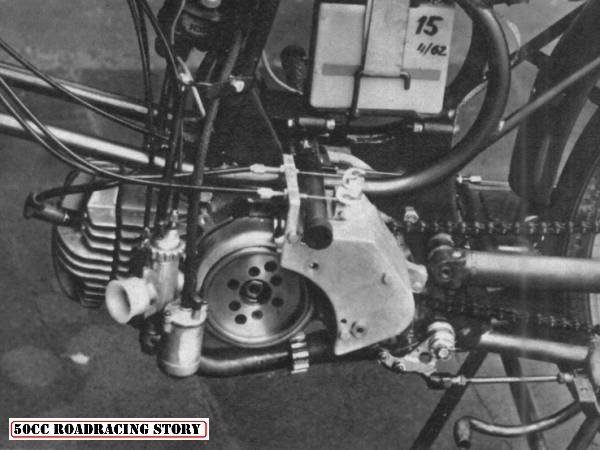 |
  |
 |
|
SuzukiOf course, a very significant entry in the 50 cc racing of 1962 was Suzuki. After Ernst Degner fled East-Germany, he joined the Suzuki team, and subsequently told the Suzuki people how to really tune a two-stoke engine, based on his experience with the MZ team. Although no-doubt he contributed tremendously to the knowledge of the Suzuki people, I think it's wrong to say that his knowledge was what gave the Japanese their advantage: it was only one year later that Yamaha really began to win races, and they certainly didn't get their knowledge from Suzuki - it was all their own research! The bike used in 1962 was called the RM62. The pics. SuziRM62 and RM62-2 show the bike on which Ernst Degner became world champion in 1962. He won the TT on Man and on Assen, the GP of Francorchamps and West-Germany, and with a further fourth in Finland and second in Argentina he won the title, ahead of Hans-Georg Anscheidt on Kreidler and Luigi Taveri on Honda. |
 |
 |
The bike had a bore and stroke of 40 x 39.5 mm for a total capacity of 49.64 cc. Compression ratio was 9 : 1 (measured from the moment of closing of the exhaust port). Air cooled engine with rotating inlet disc, 22 mm Mikuni carburettor. There was an eight speed gearbox and the total weight was 60 kg. Initially a power output of 9 to 9.5 bhp at 11,500 rpm was mentioned, but later in the season this became 10 bhp at 12,000 rpm. Top speed approximately 140 km/h. Ignition, and this held for all 50 cc Suzuki racers, by low-tension racing magneto with separate HT coils. The shock absorbers are uncommonly short. Bolts are neatly hollowed down, but the brake anchor could have done with a little slimming exercise. |
 |
 |
HondaHonda decided that they would compete in the new 50 cc class, but in this class it transpired that the four-stroke engine could not quite compete with the two-strokes. To overcome the problem, Honda developed in a very short time various new models, based on their first 50 cc machine, but in the end only came third in the world championship. The RC110 was a single cylinder with a bore and stroke of 40 x 39 mm, dimensions which were nearly the same as those of most of its competitors. The two overhead camshafts were driven by a gear train on the right hand side of the engine. The cylinder was inclined 35 degrees. The valve angle was 36 degrees on the inlet and 40 degrees on the exhaust side. Ignition was by crankshaft mounted low-tension generator and HT coil, with the contact breaker points mounted on the inlet camshaft. Compression ratio was 10.5 : 1 and power output was 9.5 bhp at 14,000 rpm. Wet sump lubrication. The bike was developed together with a street version, which explains the five-speed gearbox and a plugged kick-starter shaft opening. This five-speed gearbox was already replaced with a six-speed cluster when the first GP of the season, i.e., the Spanish GP in Barcelona, was held. For the French GP, the bore was increased to 40.4 mm, (all little things help) which brought the capacity to 49.99 cc. |
 |
 |
The machines used on Man were designated RC111. One Japanese source mentions a bore and stroke of 42.5 x 35 mm, for a total capacity of 49.7 cc. The engines had redesigned crankcases, an eight-speed gearbox and the inlet length was greater, with a long intake rubber. For Assen the bike was provided with a ten-speed gearbox, however, during the race Taveri used the eight-speed version - in Finland he used a nine-speed cluster. |
| The last race of the season was held at Suzuka, and here the RC112 made its debut, the one and only race in which it was ever deployed. It was a twin, with bore and stroke of 33 x 29 mm, giving a total capacity of 49.6 cc. Contrary to normal Honda practice, a 360° crankshaft was used, which was supported in three main bearings. Power was given as over 10 bhp at 17,500 rpm, torque was 0.45 kgm at 15,000 rpm. There were 2 valves per cylinder. Ignition was by magneto and still worked with contact breaker points(!), lubrication was with wet sump system, and the gearbox housed a nine-speed cluster. Dry weight was 62.5 kg. Tommy Robb won the race, the second 50 cc win of the season. Picture RC112 above shows the bike as ridden by Tommy Robb (photo Honda Collection Hall) - note the "Italian" looking front mudguard. |  |
 |
1962 was the year that saw the introduction of the Honda 50 cc production racer, the CR110. The CR110 was, except for the colour scheme, virtually identical to the first RC110, complete with five-speed gearbox and blinded kick-starter shaft hole. Here, too, the five speed gearbox proved inadequate, and was changed to the eight speed version. Contact breaker points were now mounted on the right hand crankcase cover, forward of the clutch, i.s.o. on the inlet camshaft. Bore and stroke 40.4 x 39 mm. The claimed power was 8.5 bhp at 13,500 rpm, maximum torque 0.46 kgm at 11,500 rpm. Carburettor diameter was 23 mm. Dry weight was 61 kg. |
DerbiA new name to appear was the Spanish Derbi, which made its debut in the Spanish GP of 1962. Thanks to ultra-light weight and daredevil riding by Busquets they managed 2nd place behind Anscheidt on a Kreidler. Funny enough it seems they still used steel i.s.o. aluminium rims. |
 |
  |
Derbi2 shows the bike somewhat later during the season, and Derbi3 is the engine with the simple 3-port cylinder with Dell'Orto carburettor, which is not the racing SS1 type, but a normal touring type, although it uses a racing type remote float chamber. |
TomosFor the 1962 season, Tomos showed up with a completely new bike, which had noting in common with the moped derived machine used in the Coupe d'Europe races However, this move was not successful, and later in the season they returned to their previous, Puch based bike. |
 |
 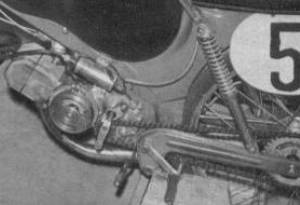 |
Although the cooling fan had (of course) gone, the rest of the engine was pure Puch, and the frame was the pressed steel one of the standard bike. Carburettor was a Dell'Orto SS1 - but I can't really admire that inlet stub, a slight sideways position next too the frame instead of that 90 degrees bend would have been much better. It was later re-positioned. |
The Outsiders
Just prior to, and during 1962, a number of 50 cc racers were developed, which were either never used or were not very successful. Here are a number of them.
|
 |
  |
  |
  |
The inlet worked of course with a rotary disc, fed by an East-German BVF carburettor and the ignition was with a 1 : 2 reduced driven racing magneto, with two sets of breaker points (to avoid floating of the points at high engine speeds). The exhaust was, in the usual MZ fashion, attached to the rear of the cylinder. The pictures crank and piston show these parts, the crank with the rotary disc attached; the hole in the front of the piston is for the third transfer port. |
DKWDKW had been a pioneer of the two-stroke technology, and had been a force to be reckoned with prior to the second world war, and had been famous for their 350 cc, three cylinder two-stroke racer, nick named "the singing saw" in the fifties, and everybody was excited when it became known, that they would try their hand at 50 cc racing. DKW1 shows the works 50cc racer used in 1962, but only in local races. The front forks are by the looks of it a smaller version of the ones as used on earlier 125 cc racers, with the shock absorber between the fork legs. The spindle clamping doesn't seem too sturdy! The engine had normal induction via the piston controlled port, with a Dell'Orto racing carb. |
 |
 |
 This bike was further developed during 1962, with two different engines: one had a normal piston controlled inlet port, the other one an inlet controlled by a rotating sleeve, not a rotating disc. See pics DKW2 and 3, showing the rotating sleeve version. However, early 1963 it was announced, that DKW would stop the development of those bikes. Lamenting in the German press, stating: "Ein schönes Märchen ging zu Ende…" (a beautiful fairy tale ended…- title of a once popular romantic song) but, to tell the truth, I for one was definitely not impressed by the pictures... This bike was further developed during 1962, with two different engines: one had a normal piston controlled inlet port, the other one an inlet controlled by a rotating sleeve, not a rotating disc. See pics DKW2 and 3, showing the rotating sleeve version. However, early 1963 it was announced, that DKW would stop the development of those bikes. Lamenting in the German press, stating: "Ein schönes Märchen ging zu Ende…" (a beautiful fairy tale ended…- title of a once popular romantic song) but, to tell the truth, I for one was definitely not impressed by the pictures...
|
Also ran (or not…)ItomItom1 shows a privately developed Itom in 1962. The home-made cylinder looks interesting, but that can't be said about the exhaust; there were still people who had obviously never heard about expansion pipes! Again steel rims - while aluminium ones were readily available. |
 |
MondialMondial is the 50cc racer developed by Italian Mondial for the 1962 season. Bore and stroke were 39 x 40 mm, most other brands had it the other way around. One overhead camshaft, driven by a gear train, and hairpin valve springs. Claimed power was 7 bhp at 14,000 rpm. The 6-speed gearbox was driven by gears. Ignition by coil and battery. Dell'Orto SS1 racing carburettor with remote float chamber. Tyre dimensions 2.25 -18, which is a little wider than most others used. Total weight of the bike was 50 kg and the top speed was approx. 130 km/h. All in all a beautiful little machine which I would love to have in my collection!  |
 |
MotomNext is the Motom, developed from a standard bike by two Italians. The builders changed the camshaft, increased the sizes of the valves (which are still much too small, compare them with the hole for the 14 mm spark plug) and installed a standard 16 mm Dell'Orto carburettor. The engine worked with push rods and developed, according to the builders, 7 bhp at 13,000 rpm. NO way! Compare this to the Mondial, and with that totally unsuitable valve gear and valve arrangement, small carb and 1000 rpm less, 7 bhp is out of the question. What's more, the top speed was 15 km/h lower than that of the Mondial, and that's a lot. The compression rings on the piston seem rather wide. The ignition worked with a flywheel magneto, and there was a five-speed gearbox. Rear suspension still with plungers(!), tyre sizes 2.00-18. Of course, nobody ever heard anything more of this bike, but it's still interesting as an example of private attempts at that time. |
 |
 |
Pictures from the races: |
| First 50cc world championship race saw a strong showing of elite riders from following factories: a four man Kreidler team: Dutchman Jan Huberts, Eurocup winner Hans George Anscheidt, Wolfgang Gedlich and Rudolph Kunz. Honda DOHC singles were ridden by Luigi Taveri, Tommy Robb, Kunimitsu Takahashi and Tom Phillis. Suzuki team riders were Ernst Degner, Mitsui Itoh, Seiichi Suzuki and Michio Ichino. Spanish teams counted both Derbi: José Maria Busquets, José Asencio, Juan Antonio Bilbao and Ricardo Fargas as well as Ducson riders: Cesar Gracia, Castor and Manuel Dato. Tomos riders were: Gilberto Parlotti, Rajco Piciga and Heinrich Rosenbusch. Furthermore was Francesco Villa with a SOHC Mondial and a Ducati with José Maria Arenas as rider present. |
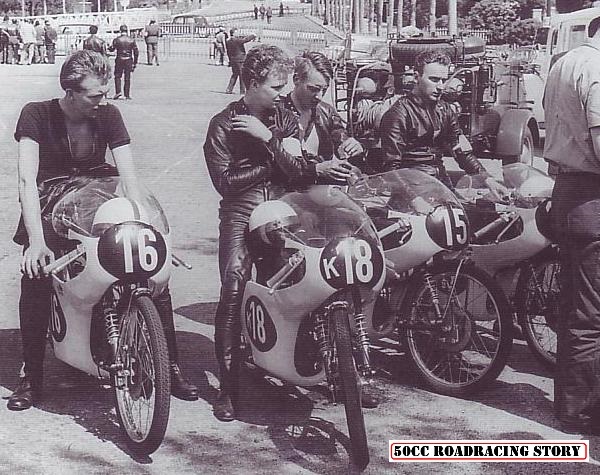  |
| 62 Montjuich Park - Kreidler team: 16 Jan Huberts, 18 Hans Georg Anscheidt, 15 Wolfgang Gedlich, 14 Rudolph Kunz. Honda riders Tommy Robb, Luigi Taveri and Teisuke Tanaka. |
  |
| Derbi team mates José Asencio and José Maria Busquets. Ducson riders Manuel Dato and Cecar Gracia. |
  |
| 62 Tomos team: Piciga, Rosenbusch ,Bernetic, Parlotti and Stefe. Mondial rider Francesco Villa. |
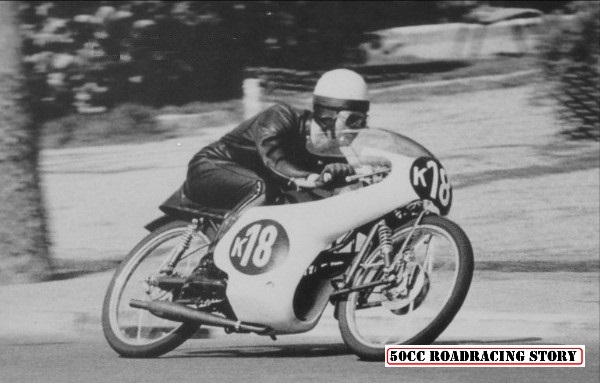 |
| Hans Georg Anscheidt during qualifying. |
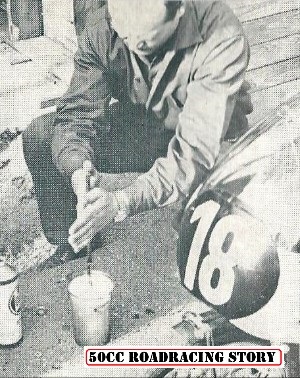   |
| Kreidler mechanic whips the fuelmix thoroughly. Kunz receives the fuelmix - Gedlig is next. Montjuich pre-start adjustments on Huberts Kreidler. |
  |
| Busquets and Anscheidt awaits start. Mitsuo Itoh ready to race the RM62 Suzuki. |
Villa had an excellent start with the Mondial 4stroke closely followed by Takahashi, Honda. Within short the Kreidler of Gedlich passed both and he was followed by local Derbi rider Busquets who drew full advantage of the cheers from spectators on his home track. At this time Taveri, fastest qualifier, was third and Takahashi fourth. Kunz had chrashed his Kreidler and Huberts had engine damage and was out too. On the third lap Anscheidt led, Gedlich second and Busquets third. At lap six it was Anscheidt, Busquets and now Taveri - one lap later and Busquets was leading, only to be re-passed by Anscheidt. Busquets passed Anscheidt again in the eleventh lap, but was beaten to the finish line by less than a second! Many were surprised by the performance of the "simple" piston- ported Derbi, but noone doubted Busquets talent! The equally piston ported Tomos of Parlotti ended in 9th place. |
  |
| 62 Montjuich Park - Busquets, Derbi - Gedlich and Anscheidt, Kreidler. Busquets leads Anscheidt and Taveri. |
   |
| Luigi Taveri, Honda RC112 third place. Ernst Degner, Suzuki came in 15th. |
  |
| Hans Georg Anscheidt takes the win in Montjuich Park. Winner Anscheidt shares flowers with runner-up Busquets. |
After this first world championship race in the 50cc class, the teams went through data and facts: Hondas Tommy Robb explains in his book, "From TT to Tokyo", how they were summoned by the team manager to explain why they didnt win this race, Taveri and Robb answered both: more speeds in the transmission! We want eight-speed transmissions! A phone call to Tokyo was made and upon arrival at the French Grand Prix at Clermont-Ferrand they were met with two new machines with eight speed transmissions. Honda meant business! |
  |
| 62 Clermont Ferrand - Kreidler team: #9 Anscheidt, #11 Huberts. Pre start at Clermont-Ferrand. |
  |
| #65 José Maria Busquets and his updated Derbi, 10hp@12500rpm. The 3 Hondas gets of to a good start! |
  |
| Taveri, Robb, and Takahashi, Honda RC112. Busquets, last race for the Derbi team 1962. |
 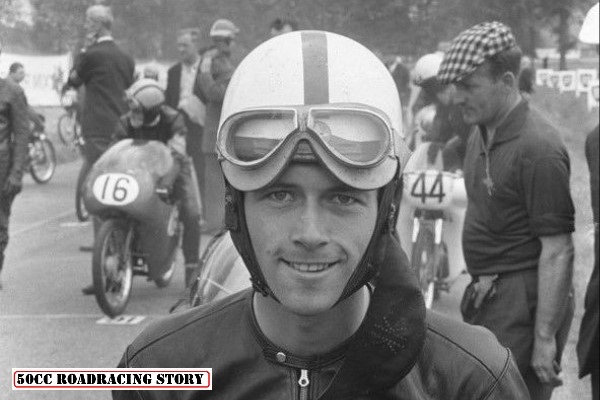 |
| Busquets fast as ever before breaking a piston ring. Dutchman Jan Huberts - winner of the second round 1962. |
 |
| Winner Jan Huberts, 2nd Kunimitsu Takahashi and 3rd Luigi Taveri. |
  |
| 62 Isle of Man - Mrs B.J.Swain prepairing her Itom for the 62 Isle of Man came in 22th. Charlie Mates, Itom with mechanic Dick Chalaye, finished 16th. |
 |
| #32 Waller, Itom - #31 Charlie Mates, Itom - #36 Fruin, Fruin Dartela - #40 Cosgrove, Itom - #42 S.Lawley, Itom - #35 Clarke, Dot - #44 Mike Simmonds, Tohatsu. |
   |
| Ernst Degner, Suzuki takes off. Luigi Taveri, 2nd. Hans Georg Anscheidt, 4th. Huberts. |
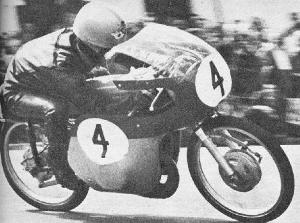   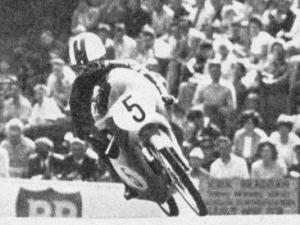 |
| Ichino-6th. Seiichi-8th. Derek Minter-9th. Simazaki-10th. |
  |
| Swain-22nd. Mitsuo Itoh-5th. |
  |
| Dan Shorey, Kreidler. Jan Huberts, Kreidler. |
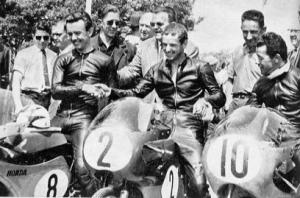  |
| 62 Isle of Man winner Ernst Degner, Suzuki - 2nd Taveri and 3rd Robb, Honda. |
  |
| 62 Assen TT start - #3 Degner, Suzuki - #6 Suzuki, Suzuki - #8 Itoh, Suzuki - #1 Taveri, Honda - #12 Huberts, Kreidler - #7 Ichino, Suzuki. |
 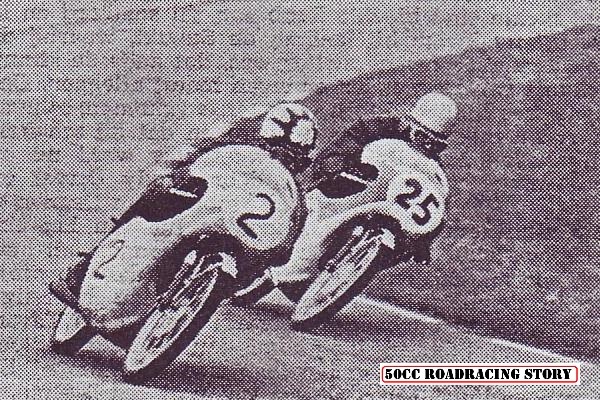 |
| #12 Huberts, Kreidler - #9 Anscheidt, Kreidler - #6 Seiichi, Suzuki. |
  |
| Runner up, Jan Huberts, Kreidler. 62 Assen finish - Ernst Degner, Jan Huberts and Anscheidt. |
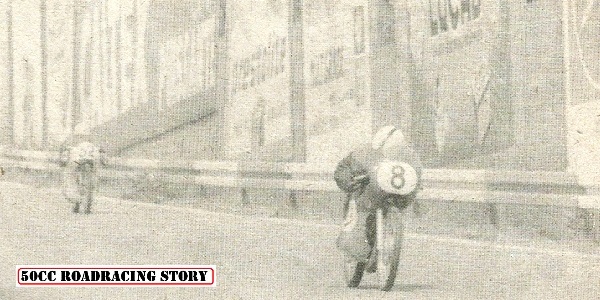  |
| 62 Spa - Degner, Suzuki - Anscheidt, Kreidler. #24 Suzuki, Suzuki - #16 Gedlich, Kreidler - #10 Taveri. Honda. |
  |
| 62 Solitude - first lap. Kunz and Asencio hits a puddle and chrashes. |
 |
| Anscheidt - Taveri - Degner - Itoh - Ioin. |
 Listen ! Anscheidt and Degner interview ! Listen ! Anscheidt and Degner interview ! |
| Jacues Roca - Derbi. |
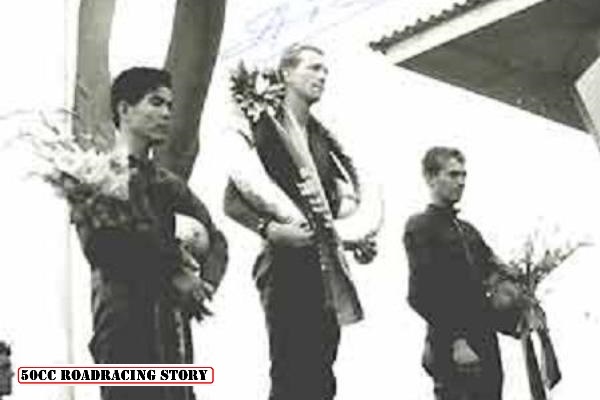  |
| 62 Sachsenring - 1 Huberts, Kreidler - 2 Itoh and 3 Anderson, both Suzuki RM62. |
  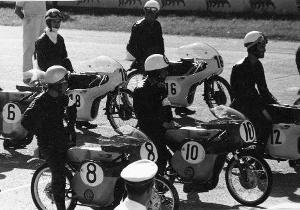 |
| Suzuki team refuels before start of the Italian GP. The start at the Monza track. |
  |
| Anscheidt chases Itoh. Winner Anscheidt, 2nd Itoh, 3rd Huberts. |
  |
| 62 Imatra - Seiichi Suzuki, Suzuki RM62. 62 Buenos Aires - Anderson, Suzuki RM62 1st. |